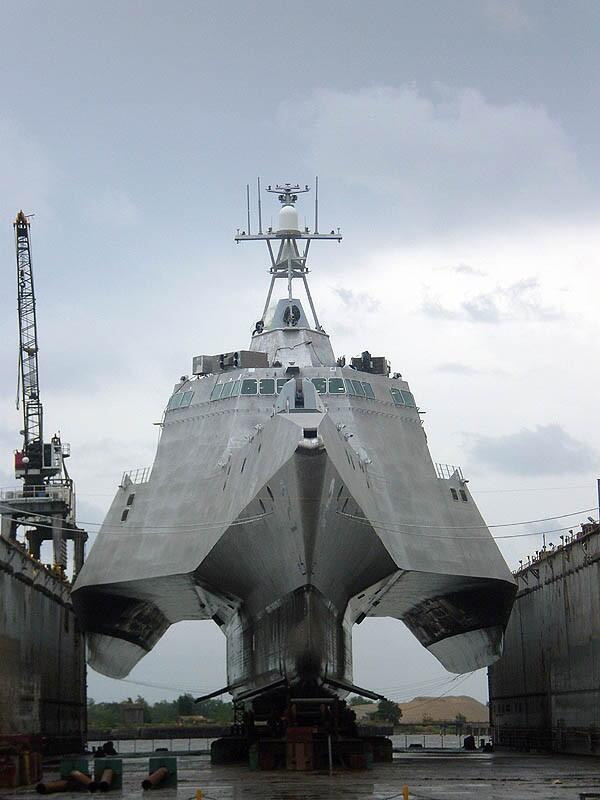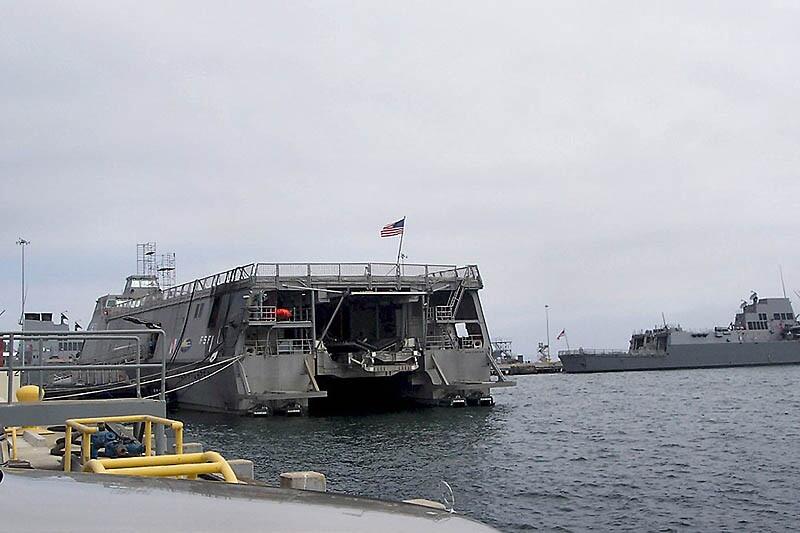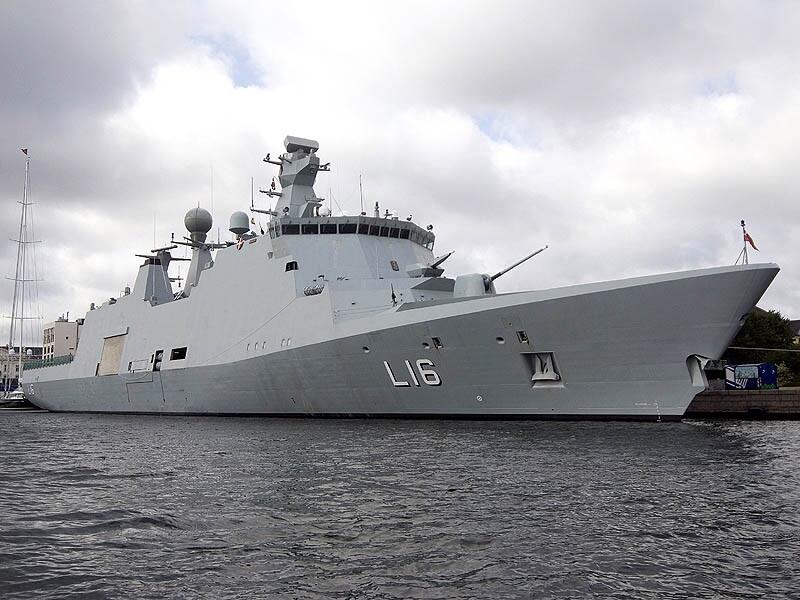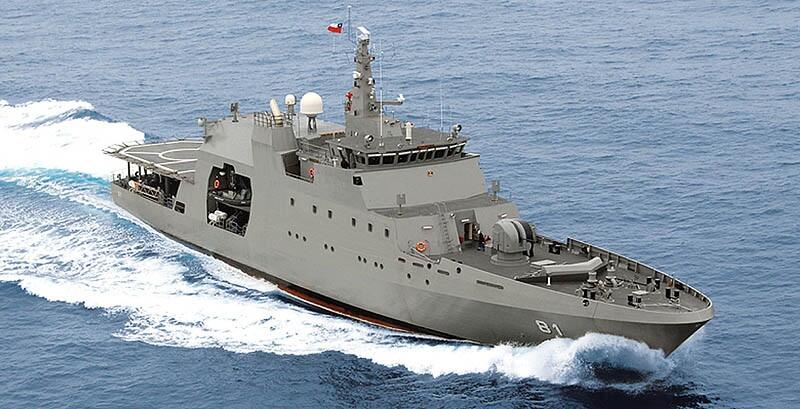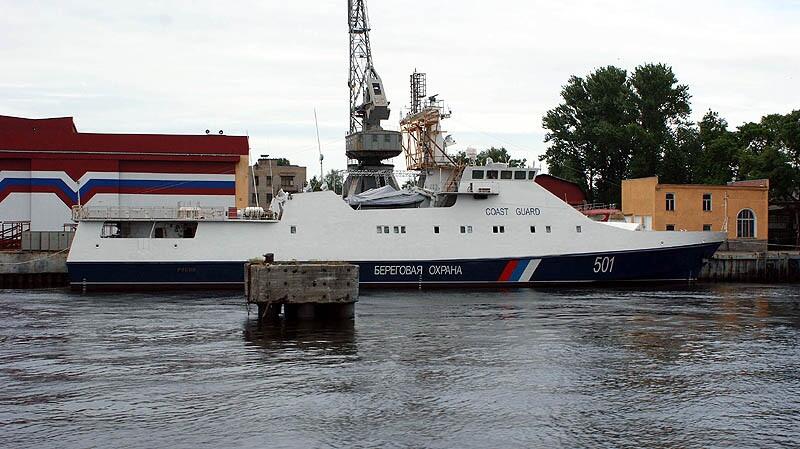TS
boleroes11
Bahasan :
(2)
• act as offline, and in cooperation with the forces and means of the armed forces of allied nations;
• solve tasks under intense enemy electronic countermeasures;
• Ensure operation of manned or unmanned aerial vehicles (with the ability to integrate family of helicopters MH-60/SN-60), remote-controlled surface and underwater vehicles;
• be in a designated area patrolled by a long period of time, as the detachment of warships, and in autonomous navigation;
• have a system of automatic control of combat and other damage;
• have the lowest levels of physical fields (technology Stealth) to reduce the visibility of the ship in different ranges;
• have a maximum effective rate of economic progress while on patrol and during long ocean crossings;
• have a relatively shallow draft, allowing to operate in shallow areas of coastal waters;
• have high combat survivability and the highest possible degree of protection of the crew;
• have the ability to perform short maneuvers at high speed (for example, in the process of separation or persecution or PL speedboats enemy);
• be able to horizon detection and destruction of their objectives prior to entering into the affected area of their own on-board equipment;
• have sopryagaemost with modern and advanced management systems and communication Navy and other branches of the armed forces, including the Allies and friendly countries;
• be able to receive fuel and cargo on the move at sea;
• Have a backup of all the major ship systems and weapons systems;
• and finally, have an acceptable purchase price and reduced operating costs.
In pre-tactical and technical requirements, the U.S. Navy issued the command developers envisaged the possibility of installing software on a ship interchangeable modules to address the following priorities:
• defense against fast single ships, warships and troops convoys of ships;
• functions of the Coast Guard ships (Border Service);
• exploration and observation;
• ASW coastal seas and oceans;
• mine operations;
• support actions of special operations forces;
LCS-2 Independence in the dock. Clearly visible underwater part of the main body and outriggers
Creating a ship with such capabilities at the first time. The main feature of this scheme was that the ship is a platform, and each individual module replacement target was to accommodate the entire weapon system (detection tools, equipment, space operators, means of destruction). In this regard, standardized way to combat module with general ship systems and data exchange channels. This would allow in the future to upgrade weapons ship, without affecting the platform itself.
First Swallow
Towing ship coastal FSF-1 Sea Fighter has a body with a large catamaran type landing deck
However, a year before the beginning of the conceptual design LCS Pentagon had decided to build towing the vessel in which it was possible to test the concept of a real high-speed maneuvering warships unconventional schemes and modular construction principle.
As a result, the Research Management U.S. Navy initiated the design and construction of an experimental ship coastal LSC (X) (Littoral Surface Craft - Experimental), dubbed «Sea Fighter» and designation FSF-1 (Fast Sea Frame). Housing catamaran type with small waterplane area was made of aluminum alloy and had a small draft. Double-hulled design provides high speed and seaworthiness, and as engines installed four jet. But the main thing - the ship was originally designed in a modular fashion, which was one of the main conditions for the realization of this project. This allowed us to work out the principle of quick-change modules for different purposes depending on the task. Compulsory provided software takeoff and landing shipborne helicopters and unmanned aerial vehicles, and use of small boats, including remote-controlled. For this British company «BMT Nigel Gee Ltd.», Asking for ship design has provided a vast landing area and large storage capacity with continuous interior cargo deck on ships as class Ro-Ro. Appearance «Sea Fighter» pluchit unusual - wide spacious deck, reverse bevels boards, small add-shifted to the left side.
Feed FSF-1 Sea Fighter. Clearly visible ramp for launching and recovery of surface and underwater vehicles
Construction was carried out on the ship shipyard «Nichols Brother's Boat Builders in Freeland, Washington. The order was placed Feb. 15, 2003, the keel was held June 5, 2003, launching February 5, 2005, and on May 31 the same year he was accepted into the U.S. Navy. «Sea Fighter» has a total displacement of 950 tons, the maximum length of 79.9 m (73 m at the waterline), width 21.9 m, draft 3.5 m Main propulsion - a combined diesel-gas turbine (two diesel MTU 16V595 TE90 and two gas turbines GE LM2500). Diesel engines are used on an economic speed and a turbine - to achieve the full stroke. Four rotary water jet installation Rolls-Royce 125SII allow the ship to reach speeds up to 50 knots (on tests achieved 59 knots), cruising range of 4,400 miles at a speed of just over 20 knots, crew - 26 people. The upper deck is equipped with two separate platforms, providing the takeoff and landing of helicopters and unmanned aerial vehicles at speeds up to full stroke. For launching and recovery aboard boats or underwater vehicles up to 11 meters is a device with retractable stern ramp, located in the center plane. Under the upper deck is a compartment for 12 interchangeable weapon stations located at the board. They rise upward special elevator, located just behind the superstructure. Using weapons systems provided mainly from helicopters and UAVs, but it is also possible accommodation modules with anti-ship missiles directly on the upper deck.
Table 1.
The main performance characteristics of the ship towing FSF-1 «Sea Fighter» U.S. Navy
Date of entry into service
31.05.2005
Hull Construction
catamaran with a small waterplane area
Displacement, tons
950
Length, m
79.9
Width, m
21.9
Draft, m
3.5
Type and composition of GEMs
2 x GE LM2500 gas turbines
DD 2 x MTU 16V595 TE90
4 x DW
Propelling
4 jet «Rolls-Royce» 125SII
Full speed, knots
50
Range, miles / at a rate bonds.
4400/20 +
Endurance, days.
20
Crew.
26
Armament:
to 12 target modules with different weapons systems, underwater and surface remotely operated vehicles
Aircraft Armament:
two helicopters MH-60 / SH-60 «Sea Hawk» or six UAV MQ-8 «Fire Scout»
Test «Sea Fighter» and its further operation immediately yielded positive results: were studied potential ships of the scheme, perfected modular principle of formation of airborne weapons, allowing depending on the type of module to solve problems that were previously only by specialized ships. The findings were used by developers actively participating in the program create LCS.
In addition, the Navy Command and U.S. Coast Guard concluded that the ships of the type «Sea Fighter» have a significant advantage when used as a ship security and law and order in their internal waters, as well as for the protection of national interests in the maritime economic zone.
Swedish corvette K32 "Helsingborg" type "Visby" built with extensive use of technology "Stealth"
Of course, "progenitor" LCS ships without any exaggeration we can assume Swedish corvette YS2000 «Visby», design and construction of which was carried out by «Kockums» since the mid-1990s. This ship was revolutionary in many technical and layout solutions:
• He had an unusual architecture of flat panels with large angles using radar absorbing structural materials (plastic composite) that dictate the terms of several orders of magnitude lower visibility of X-ray and infrared emission spectra;
• Weapons performed completely hidden inside the superstructures and flush housing, which again dictated to reducing visibility, and even a tower located outside the gun mount was "inconspicuous" design of radar absorbing material with a retractable barrel. Likewise taken mooring equipment and antenna posts - that usually increases the EPR;
• As used powerful thrusters controlled water cannon, which gave the ship a high speed and maneuverability, as well as allows you to safely operate in shallow coastal sea areas.
Introduction of technology «Stealth» on this ship is closely connected with the peculiarities of its application. Corvette must act in the coastal zone, where the presence of the archipelago, small islands and the coastline itself polyline will serve natural hindrances to enemy radar, making it difficult to detect.
Hull lines of the "deep V» give corvette «Visby» good seaworthiness due to the smaller hydrodynamic resistance. But another feature is the presence of a controlled transom plate, which reduces drag at high speeds by adjusting the trim by the stern. Superstructure located in the middle part is integral with the housing. Behind her is a helipad, which occupies more than a third the length of the ship, but no hangar, although under the upper deck space has been reserved for a light helicopter or UAV helicopter type. Displacement of the ship is 640 tons, the main dimensions of 73 x 10.4 x 2.4 meters, diesel-gas turbine plant capacity 18600 kW can achieve speeds of 35 knots, cruising range of 2,300 miles.
The main objectives of class corvettes «Visby» staged mine and anti-submarine defense of territorial waters, so their weapons, in addition to 57-mm gun mount SAK 57 L/70, includes two 127-mm anti-submarine rocket mortars, four torpedo tubes for 400-mm anti-submarine torpedoes and remotely controlled submersibles «Double Eagle» to find and destroy mines. Lighting for surface and underwater situation ship is equipped with radar «Sea Giraffe» and sonar system «Hydra» podkilnoy with towed and dipping sonar.
In January 2001, the lead ship K31 «Visby» became a member of the Swedish Navy, followed in 2001-2007 were consistently built 4 more similar corvette (sixth order was canceled due to the increased cost). In this fifth body was originally created in the shock version and was armed with two quad launchers for RCC RBS-15M (instead of mine vehicles) and installations for the 16 vertical launch SAM RBS-23 BAMSE (helicopter hangar on the site).
Further, the company «Kockums» continued work on ocean-going ships «Visby Plus», which was supposed to create on the same principle as the «Visby», but with more displacement and power weapons. First of all, this project has been focused on potential foreign customers, but ultimately, it was never implemented.
Table 2
Key performance characteristics corvette K31 «Visby» Swedish Navy
Date of entry into service
01.2005
Hull Construction
single-hull, made of composite materials, contours - "deep V», with controllable transom plate
Displacement, tons
640
Length, m
72
Width, m
10.4
Draft, m
2.4
Type and composition of GEMs
4 x GTU TF50A (16,000 kW)
DD 2 x MTU 16V 2000 N90 (2600 kW)
Propelling
2 jet
Full speed, knots
more than 35
Range, miles / at a rate bonds.
2300/18
Endurance, days.
15
Crew.
43
Armament:
1 x 57mm AU SAK 57 L/70
2 x 127-mm RBU «Alecto»
4 x 400-vv TA (torpedoes Tp45)
machines «Double Eagle»
Aircraft Armament:
light helicopter «Agusta»
Radio-electronic equipment:
3-axis radar «Sea Giraffe»
EW station
Fire control radar CEROS 200
Navigation system
HOOK «Hydra»
Complex radio
Corvette P557 "Glenten" type "Flyvefisken" Navy Denmark. Ships of this type have a modular weapons system
However, the Swedish corvette «Visby», though is the actual prototype of the American LCS, differs from it in the absence of a modular design. But if you look at the approach to the ships of the coastal zone in Denmark, we can see that the Americans - not the first, and the principle of modular replacement weapons already embodied in the metal and quite successfully. In 1989 in the Danish Navy corvette entered P550 «Flyvefisken», developed by Standard Flex 300 program. Ship full displacement of 480 tons with main dimensions 54 x 9 x 2.5 m originally was a design with standard cells (one in the nose and three aft) to download fighting modules depending on the task. Each cell for installation armament accommodates container size 3,5 × 3 × 2,5 m modules comprise the following types:
• 76,2-mm gun mounts universal OTO Melara Super Rapid;
• Two 4-container launchers RCC «Harpoon» (RCC later placed in non-retractable launchers behind the chimney);
• Installation of vertical launch Mk56 VLS for 12 anti-aircraft missiles «Sea Sparrow»;
• valve for neutral equipment and control station;
• Towed sonar device with descent and ascent on board.
In addition, the ship can be mounted removable torpedo for anti-submarine torpedoes, mine rails or remotely operated vehicles search and destruction of mines «Double Eagle». For loading and unloading of modules used mobile shore crane, and the entire operation takes about 0.5-1 hours and some time to connect and verify all complex systems (announced 48 hours). Thus, depending on the installed modules ship can be quickly converted into a missile, patrol, anti-submarine, minesweeper finder minutes or minelayer. Total for this project was built 14 ships from 1989 to 1996.
Auxiliary ship type "Absalon" Danish Navy was built to reflect the concepts of modular weapons "Standard Flex"
In the future, the Danish Navy ordered a new series of ships larger displacement corresponding to the concept of Standard Flex: helper type «Absalon» displacement of 6600 tons and patrol type «Knud Rasmussen» displacement of 1720 tons, entered service in 2004 and 2008 respectively. Both ships have a cell for standard removable containers with different sets of weapons, set depending on the task.
In other countries, too, are built to protect ships and coastal patrols, but no hurry to introduce modular design. The fact is that despite the very rationality of the idea, its economic expediency rather controversial, as the cost of development and production of high-tech modules and their service is quite high. As a result, designers are trying to create the most versatile ships with acceptable characteristics, initially allows for a wide range of tasks without any major "reconfiguration". As a rule, their main function is to patrol and surveillance of territorial waters and economic zone, environmental protection, search and rescue at sea. These ships are not powerful shock weapons, but if necessary they can be fitted, which specifically reserved room volumes. Another feature of these ships from the U.S. LCS is much smaller displacement, moderate full speed (typically less than 30 knots), while maintaining long-range navigation and classic displacement hull. Here again we see a different approach: Americans need ships, quickly reaching places the task at great distances from their own territory, and other countries - ships capable of being a long time in the area of patrol its borders and within 500-mile radius.
Chilean patrol ship PZM81 "Piloto Pard
Recent foreign ships from coastal example is the Chilean patrol ship «Piloto Pardo» project PZM, introduced in the Navy of Chile in June 2008. Its total displacement is 1728 tons, the principal dimensions of 80.6 x 13 x 3.8 meters, full speed over 20 knots, range economic progress - 6000 miles. Armament consists of a 40mm bow gun mount and two 12.7 mm machine guns. In addition, the ship carries a helicopter «Dauphin N2» and two assault boats. The tasks of the ship includes the protection of the territorial waters of Chile, search and rescue operations, monitoring the aquatic environment, as well as training for the Navy. In August 2009, was commissioned a second ship of this type - «Comandante Policarpo Toro», planned to build a total of four units.
Vietnamese patrol ship HQ-381 built by rosiyskogo project PS-500
If the reverse view on the other side of the ocean, we can cite as an example the patrol ship project PS-500, developed in the Russian Northern Design Bureau for Vietnamese Navy. It has a displacement of 610 tons and the principal dimensions of 62.2 x 11 x 2.32 meters. Hull shape made of the type "deep V», that in practice the Russian shipbuilding industry for this class of ships and tonnage applied for the first time and allowed us to obtain high seaworthiness. As the main driving forces used water cannons, informing speed 32.5 knots and giving high maneuverability (small roll on the circulation, turn on the "stop" motion lag), cruising range of 2,500 miles. The ship was built in sections on "Northern shipyard" in St. Petersburg, and the assembly of sections was carried out in Vietnam. June 24, 1998, the lead ship was launched on the shipyard Ba-Son Ho Chi Minh City, and in October 2001 he was handed over to the Vietnamese Navy. PS-500 is intended for the protection of territorial waters and economic zone, protect civilian ships and communications in the coastal areas of warships, submarines and boats of the enemy.
Russian coast guard ship "Ruby" project 22460
In Russia itself, too, is being build new patrol ships, but they have traditionally been designed not for the Navy and Marine parts Border Service. Thus, in May 2010 a solemn raising the flag on the ship project 22460, entitled "Ruby", the development of which was conducted in the Northern Design Bureau (now he is serving on the Black Sea). In the same year in the shipyard "Diamond" were laid two more ships, "Diamond" and "Pearl." Ships of this project have a displacement of 630 tons, a length of 62.5 meters, the full speed of 30 knots, cruising range of 3,500 miles. Steel housing allows to work in a young and broken ice thickness up to 20 cm Armament consists of a 30-mm six gun mount AK-630 and two 12.7 mm machine guns, but if necessary (mobilization), it can be quickly completed RCC "Uranus" SAM systems and self-defense. In addition, the ship has a helipad and provided temporary basing Ka-226 helicopter. The main purpose of the ship: the protection of the state border, the natural resources of the internal maritime waters and the territorial sea, the exclusive economic zone and continental shelf, the fight against piracy, conducting rescue operations and for environmental monitoring sea. Until 2020, plans to build 25 buildings.
[spoiler17]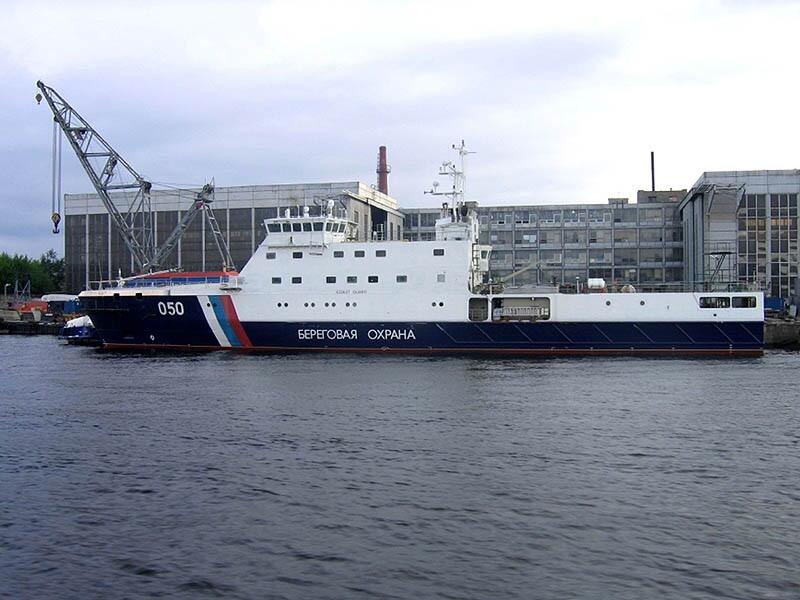 [/spoiler]
[/spoiler]
Russian coast guard ship ice class "Snowstorm" project 22120
• act as offline, and in cooperation with the forces and means of the armed forces of allied nations;
• solve tasks under intense enemy electronic countermeasures;
• Ensure operation of manned or unmanned aerial vehicles (with the ability to integrate family of helicopters MH-60/SN-60), remote-controlled surface and underwater vehicles;
• be in a designated area patrolled by a long period of time, as the detachment of warships, and in autonomous navigation;
• have a system of automatic control of combat and other damage;
• have the lowest levels of physical fields (technology Stealth) to reduce the visibility of the ship in different ranges;
• have a maximum effective rate of economic progress while on patrol and during long ocean crossings;
• have a relatively shallow draft, allowing to operate in shallow areas of coastal waters;
• have high combat survivability and the highest possible degree of protection of the crew;
• have the ability to perform short maneuvers at high speed (for example, in the process of separation or persecution or PL speedboats enemy);
• be able to horizon detection and destruction of their objectives prior to entering into the affected area of their own on-board equipment;
• have sopryagaemost with modern and advanced management systems and communication Navy and other branches of the armed forces, including the Allies and friendly countries;
• be able to receive fuel and cargo on the move at sea;
• Have a backup of all the major ship systems and weapons systems;
• and finally, have an acceptable purchase price and reduced operating costs.
In pre-tactical and technical requirements, the U.S. Navy issued the command developers envisaged the possibility of installing software on a ship interchangeable modules to address the following priorities:
• defense against fast single ships, warships and troops convoys of ships;
• functions of the Coast Guard ships (Border Service);
• exploration and observation;
• ASW coastal seas and oceans;
• mine operations;
• support actions of special operations forces;
Spoiler for 7:
LCS-2 Independence in the dock. Clearly visible underwater part of the main body and outriggers
Creating a ship with such capabilities at the first time. The main feature of this scheme was that the ship is a platform, and each individual module replacement target was to accommodate the entire weapon system (detection tools, equipment, space operators, means of destruction). In this regard, standardized way to combat module with general ship systems and data exchange channels. This would allow in the future to upgrade weapons ship, without affecting the platform itself.
First Swallow
Spoiler for 8:
Towing ship coastal FSF-1 Sea Fighter has a body with a large catamaran type landing deck
However, a year before the beginning of the conceptual design LCS Pentagon had decided to build towing the vessel in which it was possible to test the concept of a real high-speed maneuvering warships unconventional schemes and modular construction principle.
As a result, the Research Management U.S. Navy initiated the design and construction of an experimental ship coastal LSC (X) (Littoral Surface Craft - Experimental), dubbed «Sea Fighter» and designation FSF-1 (Fast Sea Frame). Housing catamaran type with small waterplane area was made of aluminum alloy and had a small draft. Double-hulled design provides high speed and seaworthiness, and as engines installed four jet. But the main thing - the ship was originally designed in a modular fashion, which was one of the main conditions for the realization of this project. This allowed us to work out the principle of quick-change modules for different purposes depending on the task. Compulsory provided software takeoff and landing shipborne helicopters and unmanned aerial vehicles, and use of small boats, including remote-controlled. For this British company «BMT Nigel Gee Ltd.», Asking for ship design has provided a vast landing area and large storage capacity with continuous interior cargo deck on ships as class Ro-Ro. Appearance «Sea Fighter» pluchit unusual - wide spacious deck, reverse bevels boards, small add-shifted to the left side.
Spoiler for 9:
Feed FSF-1 Sea Fighter. Clearly visible ramp for launching and recovery of surface and underwater vehicles
Construction was carried out on the ship shipyard «Nichols Brother's Boat Builders in Freeland, Washington. The order was placed Feb. 15, 2003, the keel was held June 5, 2003, launching February 5, 2005, and on May 31 the same year he was accepted into the U.S. Navy. «Sea Fighter» has a total displacement of 950 tons, the maximum length of 79.9 m (73 m at the waterline), width 21.9 m, draft 3.5 m Main propulsion - a combined diesel-gas turbine (two diesel MTU 16V595 TE90 and two gas turbines GE LM2500). Diesel engines are used on an economic speed and a turbine - to achieve the full stroke. Four rotary water jet installation Rolls-Royce 125SII allow the ship to reach speeds up to 50 knots (on tests achieved 59 knots), cruising range of 4,400 miles at a speed of just over 20 knots, crew - 26 people. The upper deck is equipped with two separate platforms, providing the takeoff and landing of helicopters and unmanned aerial vehicles at speeds up to full stroke. For launching and recovery aboard boats or underwater vehicles up to 11 meters is a device with retractable stern ramp, located in the center plane. Under the upper deck is a compartment for 12 interchangeable weapon stations located at the board. They rise upward special elevator, located just behind the superstructure. Using weapons systems provided mainly from helicopters and UAVs, but it is also possible accommodation modules with anti-ship missiles directly on the upper deck.
Table 1.
The main performance characteristics of the ship towing FSF-1 «Sea Fighter» U.S. Navy
Date of entry into service
31.05.2005
Hull Construction
catamaran with a small waterplane area
Displacement, tons
950
Length, m
79.9
Width, m
21.9
Draft, m
3.5
Type and composition of GEMs
2 x GE LM2500 gas turbines
DD 2 x MTU 16V595 TE90
4 x DW
Propelling
4 jet «Rolls-Royce» 125SII
Full speed, knots
50
Range, miles / at a rate bonds.
4400/20 +
Endurance, days.
20
Crew.
26
Armament:
to 12 target modules with different weapons systems, underwater and surface remotely operated vehicles
Aircraft Armament:
two helicopters MH-60 / SH-60 «Sea Hawk» or six UAV MQ-8 «Fire Scout»
Test «Sea Fighter» and its further operation immediately yielded positive results: were studied potential ships of the scheme, perfected modular principle of formation of airborne weapons, allowing depending on the type of module to solve problems that were previously only by specialized ships. The findings were used by developers actively participating in the program create LCS.
In addition, the Navy Command and U.S. Coast Guard concluded that the ships of the type «Sea Fighter» have a significant advantage when used as a ship security and law and order in their internal waters, as well as for the protection of national interests in the maritime economic zone.
Spoiler for 10:
Swedish corvette K32 "Helsingborg" type "Visby" built with extensive use of technology "Stealth"
Of course, "progenitor" LCS ships without any exaggeration we can assume Swedish corvette YS2000 «Visby», design and construction of which was carried out by «Kockums» since the mid-1990s. This ship was revolutionary in many technical and layout solutions:
• He had an unusual architecture of flat panels with large angles using radar absorbing structural materials (plastic composite) that dictate the terms of several orders of magnitude lower visibility of X-ray and infrared emission spectra;
• Weapons performed completely hidden inside the superstructures and flush housing, which again dictated to reducing visibility, and even a tower located outside the gun mount was "inconspicuous" design of radar absorbing material with a retractable barrel. Likewise taken mooring equipment and antenna posts - that usually increases the EPR;
• As used powerful thrusters controlled water cannon, which gave the ship a high speed and maneuverability, as well as allows you to safely operate in shallow coastal sea areas.
Introduction of technology «Stealth» on this ship is closely connected with the peculiarities of its application. Corvette must act in the coastal zone, where the presence of the archipelago, small islands and the coastline itself polyline will serve natural hindrances to enemy radar, making it difficult to detect.
Hull lines of the "deep V» give corvette «Visby» good seaworthiness due to the smaller hydrodynamic resistance. But another feature is the presence of a controlled transom plate, which reduces drag at high speeds by adjusting the trim by the stern. Superstructure located in the middle part is integral with the housing. Behind her is a helipad, which occupies more than a third the length of the ship, but no hangar, although under the upper deck space has been reserved for a light helicopter or UAV helicopter type. Displacement of the ship is 640 tons, the main dimensions of 73 x 10.4 x 2.4 meters, diesel-gas turbine plant capacity 18600 kW can achieve speeds of 35 knots, cruising range of 2,300 miles.
The main objectives of class corvettes «Visby» staged mine and anti-submarine defense of territorial waters, so their weapons, in addition to 57-mm gun mount SAK 57 L/70, includes two 127-mm anti-submarine rocket mortars, four torpedo tubes for 400-mm anti-submarine torpedoes and remotely controlled submersibles «Double Eagle» to find and destroy mines. Lighting for surface and underwater situation ship is equipped with radar «Sea Giraffe» and sonar system «Hydra» podkilnoy with towed and dipping sonar.
In January 2001, the lead ship K31 «Visby» became a member of the Swedish Navy, followed in 2001-2007 were consistently built 4 more similar corvette (sixth order was canceled due to the increased cost). In this fifth body was originally created in the shock version and was armed with two quad launchers for RCC RBS-15M (instead of mine vehicles) and installations for the 16 vertical launch SAM RBS-23 BAMSE (helicopter hangar on the site).
Further, the company «Kockums» continued work on ocean-going ships «Visby Plus», which was supposed to create on the same principle as the «Visby», but with more displacement and power weapons. First of all, this project has been focused on potential foreign customers, but ultimately, it was never implemented.
Table 2
Key performance characteristics corvette K31 «Visby» Swedish Navy
Date of entry into service
01.2005
Hull Construction
single-hull, made of composite materials, contours - "deep V», with controllable transom plate
Displacement, tons
640
Length, m
72
Width, m
10.4
Draft, m
2.4
Type and composition of GEMs
4 x GTU TF50A (16,000 kW)
DD 2 x MTU 16V 2000 N90 (2600 kW)
Propelling
2 jet
Full speed, knots
more than 35
Range, miles / at a rate bonds.
2300/18
Endurance, days.
15
Crew.
43
Armament:
1 x 57mm AU SAK 57 L/70
2 x 127-mm RBU «Alecto»
4 x 400-vv TA (torpedoes Tp45)
machines «Double Eagle»
Aircraft Armament:
light helicopter «Agusta»
Radio-electronic equipment:
3-axis radar «Sea Giraffe»
EW station
Fire control radar CEROS 200
Navigation system
HOOK «Hydra»
Complex radio
Spoiler for 11:
Corvette P557 "Glenten" type "Flyvefisken" Navy Denmark. Ships of this type have a modular weapons system
However, the Swedish corvette «Visby», though is the actual prototype of the American LCS, differs from it in the absence of a modular design. But if you look at the approach to the ships of the coastal zone in Denmark, we can see that the Americans - not the first, and the principle of modular replacement weapons already embodied in the metal and quite successfully. In 1989 in the Danish Navy corvette entered P550 «Flyvefisken», developed by Standard Flex 300 program. Ship full displacement of 480 tons with main dimensions 54 x 9 x 2.5 m originally was a design with standard cells (one in the nose and three aft) to download fighting modules depending on the task. Each cell for installation armament accommodates container size 3,5 × 3 × 2,5 m modules comprise the following types:
• 76,2-mm gun mounts universal OTO Melara Super Rapid;
• Two 4-container launchers RCC «Harpoon» (RCC later placed in non-retractable launchers behind the chimney);
• Installation of vertical launch Mk56 VLS for 12 anti-aircraft missiles «Sea Sparrow»;
• valve for neutral equipment and control station;
• Towed sonar device with descent and ascent on board.
In addition, the ship can be mounted removable torpedo for anti-submarine torpedoes, mine rails or remotely operated vehicles search and destruction of mines «Double Eagle». For loading and unloading of modules used mobile shore crane, and the entire operation takes about 0.5-1 hours and some time to connect and verify all complex systems (announced 48 hours). Thus, depending on the installed modules ship can be quickly converted into a missile, patrol, anti-submarine, minesweeper finder minutes or minelayer. Total for this project was built 14 ships from 1989 to 1996.
Spoiler for 12:
Auxiliary ship type "Absalon" Danish Navy was built to reflect the concepts of modular weapons "Standard Flex"
In the future, the Danish Navy ordered a new series of ships larger displacement corresponding to the concept of Standard Flex: helper type «Absalon» displacement of 6600 tons and patrol type «Knud Rasmussen» displacement of 1720 tons, entered service in 2004 and 2008 respectively. Both ships have a cell for standard removable containers with different sets of weapons, set depending on the task.
In other countries, too, are built to protect ships and coastal patrols, but no hurry to introduce modular design. The fact is that despite the very rationality of the idea, its economic expediency rather controversial, as the cost of development and production of high-tech modules and their service is quite high. As a result, designers are trying to create the most versatile ships with acceptable characteristics, initially allows for a wide range of tasks without any major "reconfiguration". As a rule, their main function is to patrol and surveillance of territorial waters and economic zone, environmental protection, search and rescue at sea. These ships are not powerful shock weapons, but if necessary they can be fitted, which specifically reserved room volumes. Another feature of these ships from the U.S. LCS is much smaller displacement, moderate full speed (typically less than 30 knots), while maintaining long-range navigation and classic displacement hull. Here again we see a different approach: Americans need ships, quickly reaching places the task at great distances from their own territory, and other countries - ships capable of being a long time in the area of patrol its borders and within 500-mile radius.
Spoiler for 13:
Chilean patrol ship PZM81 "Piloto Pard
Recent foreign ships from coastal example is the Chilean patrol ship «Piloto Pardo» project PZM, introduced in the Navy of Chile in June 2008. Its total displacement is 1728 tons, the principal dimensions of 80.6 x 13 x 3.8 meters, full speed over 20 knots, range economic progress - 6000 miles. Armament consists of a 40mm bow gun mount and two 12.7 mm machine guns. In addition, the ship carries a helicopter «Dauphin N2» and two assault boats. The tasks of the ship includes the protection of the territorial waters of Chile, search and rescue operations, monitoring the aquatic environment, as well as training for the Navy. In August 2009, was commissioned a second ship of this type - «Comandante Policarpo Toro», planned to build a total of four units.
Spoiler for 14:
Vietnamese patrol ship HQ-381 built by rosiyskogo project PS-500
If the reverse view on the other side of the ocean, we can cite as an example the patrol ship project PS-500, developed in the Russian Northern Design Bureau for Vietnamese Navy. It has a displacement of 610 tons and the principal dimensions of 62.2 x 11 x 2.32 meters. Hull shape made of the type "deep V», that in practice the Russian shipbuilding industry for this class of ships and tonnage applied for the first time and allowed us to obtain high seaworthiness. As the main driving forces used water cannons, informing speed 32.5 knots and giving high maneuverability (small roll on the circulation, turn on the "stop" motion lag), cruising range of 2,500 miles. The ship was built in sections on "Northern shipyard" in St. Petersburg, and the assembly of sections was carried out in Vietnam. June 24, 1998, the lead ship was launched on the shipyard Ba-Son Ho Chi Minh City, and in October 2001 he was handed over to the Vietnamese Navy. PS-500 is intended for the protection of territorial waters and economic zone, protect civilian ships and communications in the coastal areas of warships, submarines and boats of the enemy.
Spoiler for 16:
Russian coast guard ship "Ruby" project 22460
In Russia itself, too, is being build new patrol ships, but they have traditionally been designed not for the Navy and Marine parts Border Service. Thus, in May 2010 a solemn raising the flag on the ship project 22460, entitled "Ruby", the development of which was conducted in the Northern Design Bureau (now he is serving on the Black Sea). In the same year in the shipyard "Diamond" were laid two more ships, "Diamond" and "Pearl." Ships of this project have a displacement of 630 tons, a length of 62.5 meters, the full speed of 30 knots, cruising range of 3,500 miles. Steel housing allows to work in a young and broken ice thickness up to 20 cm Armament consists of a 30-mm six gun mount AK-630 and two 12.7 mm machine guns, but if necessary (mobilization), it can be quickly completed RCC "Uranus" SAM systems and self-defense. In addition, the ship has a helipad and provided temporary basing Ka-226 helicopter. The main purpose of the ship: the protection of the state border, the natural resources of the internal maritime waters and the territorial sea, the exclusive economic zone and continental shelf, the fight against piracy, conducting rescue operations and for environmental monitoring sea. Until 2020, plans to build 25 buildings.
[spoiler17]
 [/spoiler]
[/spoiler]Russian coast guard ship ice class "Snowstorm" project 22120
0
6K
18
Thread Digembok
Urutan
Terbaru
Terlama
Thread Digembok
Komunitas Pilihan
